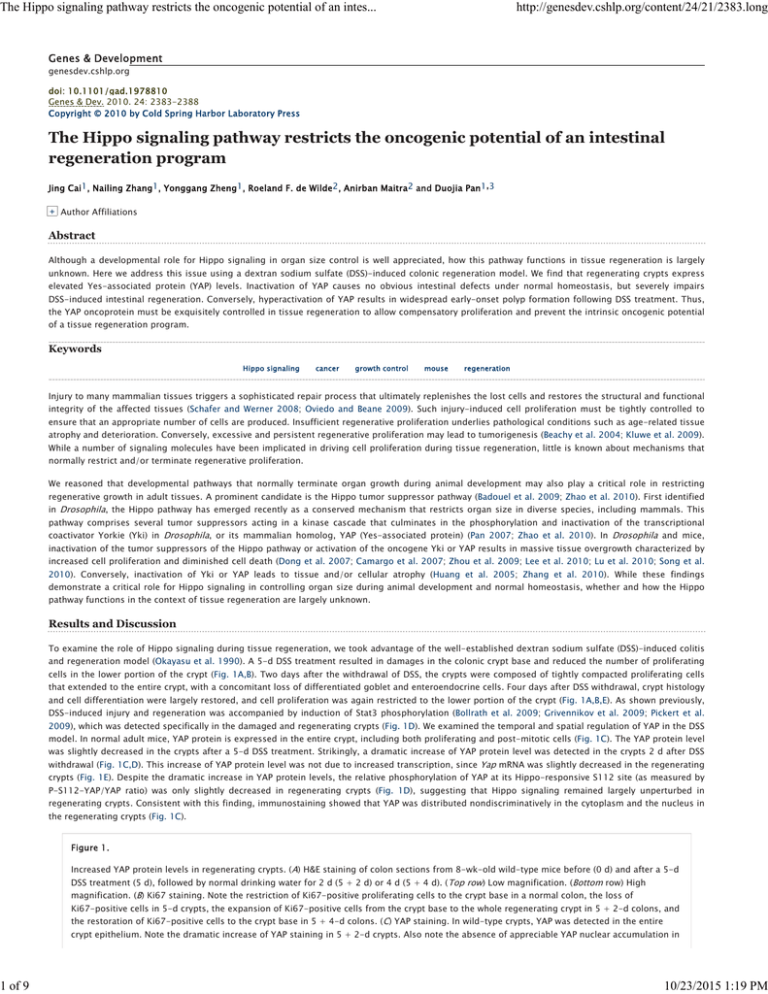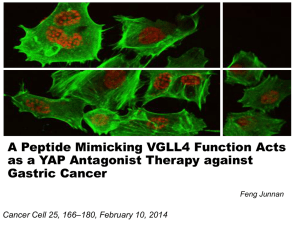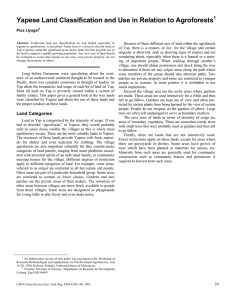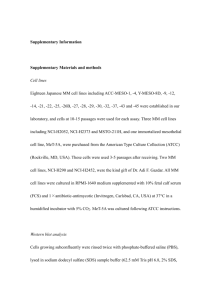The Hippo signaling pathway restricts the oncogenic potential of an... regeneration program Genes & Development Abstract
advertisement

The Hippo signaling pathway restricts the oncogenic potential of an intes...
1 of 9
http://genesdev.cshlp.org/content/24/21/2383.long
Genes & Development
genesdev.cshlp.org
doi: 10.1101/gad.1978810
Genes & Dev. 2010. 24: 2383-2388
Copyright © 2010 by Cold Spring Harbor Laboratory Press
The Hippo signaling pathway restricts the oncogenic potential of an intestinal
regeneration program
Jing Cai1, Nailing Zhang1, Yonggang Zheng1, Roeland F. de Wilde2, Anirban Maitra2 and Duojia Pan1,3
+ Author Affiliations
Abstract
Although a developmental role for Hippo signaling in organ size control is well appreciated, how this pathway functions in tissue regeneration is largely
unknown. Here we address this issue using a dextran sodium sulfate (DSS)-induced colonic regeneration model. We find that regenerating crypts express
elevated Yes-associated protein (YAP) levels. Inactivation of YAP causes no obvious intestinal defects under normal homeostasis, but severely impairs
DSS-induced intestinal regeneration. Conversely, hyperactivation of YAP results in widespread early-onset polyp formation following DSS treatment. Thus,
the YAP oncoprotein must be exquisitely controlled in tissue regeneration to allow compensatory proliferation and prevent the intrinsic oncogenic potential
of a tissue regeneration program.
Keywords
Hippo signaling
cancer
growth control
mouse
regeneration
Injury to many mammalian tissues triggers a sophisticated repair process that ultimately replenishes the lost cells and restores the structural and functional
integrity of the affected tissues (Schafer and Werner 2008; Oviedo and Beane 2009). Such injury-induced cell proliferation must be tightly controlled to
ensure that an appropriate number of cells are produced. Insufficient regenerative proliferation underlies pathological conditions such as age-related tissue
atrophy and deterioration. Conversely, excessive and persistent regenerative proliferation may lead to tumorigenesis (Beachy et al. 2004; Kluwe et al. 2009).
While a number of signaling molecules have been implicated in driving cell proliferation during tissue regeneration, little is known about mechanisms that
normally restrict and/or terminate regenerative proliferation.
We reasoned that developmental pathways that normally terminate organ growth during animal development may also play a critical role in restricting
regenerative growth in adult tissues. A prominent candidate is the Hippo tumor suppressor pathway (Badouel et al. 2009; Zhao et al. 2010). First identified
in Drosophila, the Hippo pathway has emerged recently as a conserved mechanism that restricts organ size in diverse species, including mammals. This
pathway comprises several tumor suppressors acting in a kinase cascade that culminates in the phosphorylation and inactivation of the transcriptional
coactivator Yorkie (Yki) in Drosophila, or its mammalian homolog, YAP (Yes-associated protein) (Pan 2007; Zhao et al. 2010). In Drosophila and mice,
inactivation of the tumor suppressors of the Hippo pathway or activation of the oncogene Yki or YAP results in massive tissue overgrowth characterized by
increased cell proliferation and diminished cell death (Dong et al. 2007; Camargo et al. 2007; Zhou et al. 2009; Lee et al. 2010; Lu et al. 2010; Song et al.
2010). Conversely, inactivation of Yki or YAP leads to tissue and/or cellular atrophy (Huang et al. 2005; Zhang et al. 2010). While these findings
demonstrate a critical role for Hippo signaling in controlling organ size during animal development and normal homeostasis, whether and how the Hippo
pathway functions in the context of tissue regeneration are largely unknown.
Results and Discussion
To examine the role of Hippo signaling during tissue regeneration, we took advantage of the well-established dextran sodium sulfate (DSS)-induced colitis
and regeneration model (Okayasu et al. 1990). A 5-d DSS treatment resulted in damages in the colonic crypt base and reduced the number of proliferating
cells in the lower portion of the crypt (Fig. 1A,B). Two days after the withdrawal of DSS, the crypts were composed of tightly compacted proliferating cells
that extended to the entire crypt, with a concomitant loss of differentiated goblet and enteroendocrine cells. Four days after DSS withdrawal, crypt histology
and cell differentiation were largely restored, and cell proliferation was again restricted to the lower portion of the crypt (Fig. 1A,B,E). As shown previously,
DSS-induced injury and regeneration was accompanied by induction of Stat3 phosphorylation (Bollrath et al. 2009; Grivennikov et al. 2009; Pickert et al.
2009), which was detected specifically in the damaged and regenerating crypts (Fig. 1D). We examined the temporal and spatial regulation of YAP in the DSS
model. In normal adult mice, YAP protein is expressed in the entire crypt, including both proliferating and post-mitotic cells (Fig. 1C). The YAP protein level
was slightly decreased in the crypts after a 5-d DSS treatment. Strikingly, a dramatic increase of YAP protein level was detected in the crypts 2 d after DSS
withdrawal (Fig. 1C,D). This increase of YAP protein level was not due to increased transcription, since Yap mRNA was slightly decreased in the regenerating
crypts (Fig. 1E). Despite the dramatic increase in YAP protein levels, the relative phosphorylation of YAP at its Hippo-responsive S112 site (as measured by
P-S112-YAP/YAP ratio) was only slightly decreased in regenerating crypts (Fig. 1D), suggesting that Hippo signaling remained largely unperturbed in
regenerating crypts. Consistent with this finding, immunostaining showed that YAP was distributed nondiscriminatively in the cytoplasm and the nucleus in
the regenerating crypts (Fig. 1C).
Figure 1.
Increased YAP protein levels in regenerating crypts. (A) H&E staining of colon sections from 8-wk-old wild-type mice before (0 d) and after a 5-d
DSS treatment (5 d), followed by normal drinking water for 2 d (5 + 2 d) or 4 d (5 + 4 d). ( Top row) Low magnification. (Bottom row) High
magnification. (B) Ki67 staining. Note the restriction of Ki67-positive proliferating cells to the crypt base in a normal colon, the loss of
Ki67-positive cells in 5-d crypts, the expansion of Ki67-positive cells from the crypt base to the whole regenerating crypt in 5 + 2-d colons, and
the restoration of Ki67-positive cells to the crypt base in 5 + 4-d colons. (C) YAP staining. In wild-type crypts, YAP was detected in the entire
crypt epithelium. Note the dramatic increase of YAP staining in 5 + 2-d crypts. Also note the absence of appreciable YAP nuclear accumulation in
10/23/2015 1:19 PM
The Hippo signaling pathway restricts the oncogenic potential of an intes...
2 of 9
http://genesdev.cshlp.org/content/24/21/2383.long
control and regenerating crypts. (D) Western blotting analysis. Protein extracts from control and
regenerating crypts were probed with the indicated antibodies. Note the increase of YAP, P-YAP, and
P-Stat3 in 5 + 2-d and 5 + 4-d crypts. The YAP protein level and P-YAP/YAP ratio were quantified in the
graphs to the right. Data are mean ± SD. n = 3. (*) P < 0.01, t-test. (E) Real-time PCR analysis. mRNAs
from control and regenerating crypts were analyzed for the expression of the indicated genes. Note the
decrease of Yap mRNA in 5 + 2-d and 5 + 4-d crypts. Also note the decreased expression of the goblet
cell marker Mucin2 and the enteroendocrine cell marker Chromogranin A (ChgA) in 5 + 2-d crypts, and
the recovery of their expression levels in 5 + 4-d crypts. Data are mean ± SD. n = 3. (*) P < 0.01, t-test.
Bars, 100 μm.
View larger version:
In this page
In a new window
Download as PowerPoint Slide
The dramatic increase in YAP protein levels in regenerating crypts suggests that YAP may play a potential role in intestinal regeneration. To investigate this
possibility, we crossed a conditional knockout allele of Yap with Villin-Cre (VilCre), which results in gene deletion in the epithelium of the small intestine
and colon starting at embryonic day 12.5 (E12.5) (Madison et al. 2002). VilCre;Yapflox/flox mice developed normally, and histological analysis of adult mice
revealed no visible defects in cell differentiation, cell death, cell proliferation, or cell migration along the crypt–villus axis (Fig. 3; Supplemental Figs. S1,
S3D,E), suggesting that YAP is dispensable for normal intestinal homeostasis. Following DSS treatment, however, VilCre;Yapflox/flox mice showed a dramatic
increase in mortality rate and a rapid decrease in body weight compared with the control littermates (Fig. 2A). Histological analysis revealed substantial
damage with significant loss of crypts and scattered colonic epithelial cells in the VilCre;Yapflox/flox mice compared with the control littermates (Fig. 2B,C).
Furthermore, the VilCre;Yapflox/flox colon contained fewer proliferating cells and more apoptotic cells (Fig. 2D,E). Thus, while YAP is largely dispensable for
intestinal homeostasis under normal conditions, it is required for DSS-induced crypt regeneration.
Figure 2.
Impaired regeneration of Yap-deficient colonic crypts. (A) Increased mortality and loss of body weight in
Yap-deficient mice after DSS treatment. Mice were treated with 2.5% DSS for 7 d and supplied with
normal drinking water thereafter. Thirteen wild-type and nine Yap-deficient mice were treated for
mortality rate analysis. Nine wild-type and eight Yap-deficient mice were treated for body weight
analysis. (*) P < 0.05; (**) P < 0.01, t-test. (B) H&E staining of colon sections after a 7-d DSS treatment.
(Top row) Low magnification. (Bottom row) High magnification. Note the absence of crypt structure and
the expansion of stromal cells in Yap-deficient colons. (C) Histological score of colons after a 7-d DSS
treatment. Tissue damages were quantified as described in the Materials and Methods. Eight wild-type
and nine Yap-deficient mice were treated for this analysis. Data are mean ± SEM. (*) P < 0.05, t-test.
View larger version:
In this page
In a new window
(D,E) Ki67 and cleaved caspase-3 staining showing fewer proliferating and more apoptotic cells in
Yap-deficient crypts after DSS treatment. Bars, 100 μm.
Download as PowerPoint Slide
Figure 3.
Loss of Sav1 results in Yap-dependent crypt hyperplasia. (A) Isolated colonic crypts from 4-wk-old
wild-type, Sav1, Yap, or Sav1 Yap double-mutant colons. Note the enlarged width of Sav1 mutant crypts.
Quantification of crypt width is shown in C, graph i. (B) H&E staining of the colonic sections from
4-wk-old wild-type, Sav1, Yap, or Sav1 Yap double-mutant colons. Note the enlarged width of Sav1
mutant crypts. (C, graph i) Quantification of crypt width from A. Eighty crypts from three mice of each
genotype were used. Data are mean ± SEM. (*) P < 0.01, t-test. (Graph ii) Quantification of cell
proliferation. Four-week-old wild-type, Sav1, Yap, or Sav1 Yap double-mutant mice were analyzed for
BrdU and Ki67 staining 2 h after a single i.p. injection of BrdU. The number of BrdU+ or Ki67+ cells and
the ratio of BrdU+/Ki67+ in each crypt were quantified with 200 crypts from three mice of each
View larger version:
In this page
In a new window
Download as PowerPoint Slide
genotype. Data are mean ± SEM. (*) P < 0.01, t-test. (D) Quantification of YAP protein and mRNA levels.
Note the increased YAP protein and mRNA levels in Sav1-deficient crypts. Also note that, while the
absolute amount of P-YAP was similar in wild-type and Sav1-deficient crypts, the P-YAP/YAP ratio was
decreased in Sav1-deficient crypts. Data used in the graph are mean ± SD. n = 3. (*) P < 0.01, t-test.
Bars, 100 μm.
The inconsequentiality of YAP loss for normal intestinal homeostasis can be compatible with at least two possibilities: the Hippo pathway may be simply
dispensable, or, alternatively, Hippo signaling may be constitutively activated such that YAP is kept largely inactive under normal homeostasis. The latter,
but not the former, model predicts that inactivation of tumor suppressors that normally restrict YAP activity may lead to tumor formation and/or intestinal
overgrowth due to hyperactivation of the YAP oncoprotein. To investigate this possibility, we generated conditional knockout mice for the Hippo pathway
component Sav1 (Supplemental Fig. S2). Consistent with the latter model, 4-wk-old VilCre;Sav1flox/flox mice showed an enlargement of crypts in both the
colon and small intestine, which contained more and faster proliferating cells (Fig. 3A–C; Supplemental Fig. S3). Interestingly, the hyperplasia of
Sav1-deficient crypts was completely reversed by loss of YAP, even though the latter by itself had no visible effect on normal crypt morphology or cell
proliferation (Fig. 3A–C; Supplemental Fig. S3). Consistent with the genetic suppression of the Sav1-deficient phenotype by loss of Yap, Sav1-deficient
10/23/2015 1:19 PM
The Hippo signaling pathway restricts the oncogenic potential of an intes...
3 of 9
http://genesdev.cshlp.org/content/24/21/2383.long
crypts showed decreased YAP S112 phosphorylation (Fig. 3D) as well as nuclear accumulation of YAP (Supplemental Fig. S2E), in contrast to its
nondiscriminative subcellular localization in normal or regenerating crypts (Fig. 1C). By 13 mo of age, all male VilCre;Sav1flox/flox mice had developed
colonic polyps (average number 1.71 ± 0.76, n = 7), whereas none of the control male littermates developed any polyps at a comparable age (n = 12) (Fig.
4A). Histological analysis revealed that the polyps did not resemble the prototypal intestinal adenomas observed in the ApcMin model of tumorigenesis
(Moser et al. 1990; Su et al. 1992). In contrast, there were prominent invaginations of the hyperplastic epithelium leading to a “saw-tooth” appearance of
the glands, a feature characteristic of sessile serrated polyps (SSPs), which comprise a recently catalogued alternative pathway to colorectal neoplasia in
humans (Fig. 4B, panel i; Montgomery 2004; Snover et al. 2005). Over time, SSPs left in situ are prone to adenomatous transformation and the development
of invasive adenocarcinomas (Montgomery 2004; Snover et al. 2005). Indeed, such an adenomatous transformation (Fig. 4B, panel ii) and invasion of the
muscularis mucosa by neoplastic glands (Fig. 4B, panel iii) were observed. The Sav1-deficient SSPs showed nuclear accumulation of YAP, but not nuclear
accumulation of β-catenin or elevated overall levels of β-catenin (Fig. 4D,E), further underscoring their distinction from the conventional tubular adenomas.
Consistent with the complete suppression of Sav1 loss-induced crypt hyperplasia by loss of YAP in younger mice, none of the aged
VilCre;Sav1flox/flox;Yapflox/flox (n = 6 males) and VilCre;Yapflox/flox mice (n = 6 males) developed any polyps or histological abnormalities in the colon. To
our knowledge, the VilCre;Sav1flox/flox mice described here represent the first mouse model for SSPs.
Figure 4.
SSP development in Sav1-deficient mouse colons and the prevalence of Hippo pathway dysregulation in
human SSPs. (A) Distal colon of 13-mo-old wild-type control and Sav1-deficient littermates. Note the
presence of two polyps in the Sav1-deficient colon (black arrows). (B) H&E staining of the colonic sections
from 13-mo-old wild-type control (left) and Sav1-deficient (right) littermates. The top and bottom
panels show the corresponding low- and high-magnification images, respectively. Note the presence of
serrated polyps with “saw-tooth” crypt epithelium (asterisk in panel i), adenomatous transformation
(arrow in panel ii), and invasion of the muscularis mucosa (arrow in panel iii) in Sav1-deficient colons. (C)
View larger version:
In this page
In a new window
Download as PowerPoint Slide
Ki67 staining. Note that Ki67-positive proliferating cells were restricted to the crypt base in control
colons. In Sav1-deficient colons, scattered Ki67-positive cells were detected throughout the crypt
epithelia. (D,E) YAP and β-catenin staining. Note the accumulation of nuclear YAP but not nuclear
β-catenin in Sav1-deficient colonic polyps (arrows). (F–J) Analysis of human SSPs. (F) Summary of YAP and
β-catenin staining in human SSPs. (G) Histopathology of a right-sided SSP obtained by endoscopic
excision. H&E stain, 10× magnification. Note the characteristic polypoid epithelium. (H) Up-regulation of
YAP in the polypoid epithelium of an SSP compared with adjacent normal colonic epithelium. At the
bottom right half of the panel, one gland was partially involved by SSP and demonstrated YAP up-regulation (white arrowhead), while the
nonneoplastic half of the gland had minimal expression (black arrowhead). (I) High-power magnification of SSP epithelium with nuclear YAP
labeling. Magnification, 40×. (J) Absence of nuclear β-catenin, with retained membranous localization of the protein, in the serial section of the
SSP shown in D. Magnification, 40×. Bars, 100 μm.
The development of SSPs in Sav1-deficient mouse colons prompted us to investigate whether aberrant Hippo signaling may be a general hallmark of SSPs in
humans. Therefore, we examined the expression and subcellular localization of YAP and β-catenin proteins in an archival collection of 14 histologically
documented SSPs that had been endoscopically removed (Fig. 4F–J). All of the 14 SSPs (100%) demonstrated up-regulation of YAP protein, compared with
the adjacent normal colonic mucosa (Fig. 4F,H). Eleven of 14 (78%) SSPs demonstrated unequivocal nuclear YAP accumulation within the polypoid
epithelium, while three of 14 (22%) demonstrated only infrequent nuclear YAP labeling, although cytoplasmic protein was still up-regulated compared with
the colonic epithelium. Of note, in the 11 SSPs with nuclear YAP localization, we confirmed the absence of nuclear β-catenin in serial sections of the
polypoid epithelium, and its restriction to the membranous and cytoplasmic compartments (Fig. 4I,J). Thus, as in Sav1-deficient mouse colons (Fig. 4D,E),
nuclear localization of YAP occurs in the absence of nuclear or overall β-catenin accumulation in human SSPs.
The dispensable role for Yap but not Sav1 in normal intestinal growth is consistent with the view that, under normal homeostasis, the Hippo pathway keeps
the YAP oncoprotein in a relatively inactive state. This raises the critical question of why intestinal cells invest the energy to synthesize a growth regulator
like YAP, but meanwhile employ an elaborate signaling cascade to turn off its activity. An attractive model is that the intestinal epithelia, which are
constantly exposed to environmental insults, must be poised for regeneration in anticipation of severe tissue damage. This regenerative capacity, which is
YAP-dependent, must be kept in check by the Hippo pathway to prevent excessive proliferation. Our observation that loss of Sav1 leads to crypt hyperplasia
and tumorigenesis under normal homeostasis is consistent with this model. We further reasoned that Hippo-mediated suppression of YAP may be even
more critical for preventing tumorigenesis during DSS-induced intestinal repair, when regenerating crypts express highly elevated levels of the YAP
oncoprotein. To test this hypothesis, we treated 12-wk-old wild-type control, VilCre;Sav1flox/flox, VilCre;Sav1flox/flox;Yapflox/flox, and VilCre;Yapflox/flox
mice with DSS for 4 d and allowed them to grow for 3 mo with normal drinking water. Strikingly, all VilCre;Sav1flox/flox mice developed multiple colonic
polyps by 3 mo (n = 7), whereas none of the age- and treatment-matched control littermates developed colonic polyps (n = 8), nor did any
VilCre;Sav1flox/flox mice without DSS treatment (n = 8) at a comparable age (Fig. 5A). In fact, the latter did not develop colonic polyps before 12 mo of age.
This enhanced tumorigenicity is YAP dependent, as none of the age- and treatment-matched VilCre;Sav1flox/flox;Yapflox/flox (n = 5) or VilCre;Yapflox/flox (n
= 5) mice developed colonic polyps. Histological analysis and Ki67 staining revealed the presence of SSPs in DSS-induced Sav1-deficient colons (Fig. 5B,C).
Like the late-onset polyps observed in Sav1-deficient colons without DSS treatment, the DSS-induced Sav1-deficient polyps showed an accumulation of
nuclear YAP (Fig. 5D). Taken together, we conclude that DSS-induced injury and repair greatly exacerbated the tumorigenicity of the Sav1-deficient crypts.
Figure 5.
DSS-induced regeneration accelerated polyp development in Sav1-deficient colons in a Yap-dependent manner. (A) Distal colon of 12-wk-old
wild-type, Sav1, Yap, or Sav1 Yap double-mutant mice treated with 2.5% DSS for 4 d, followed by normal drinking water for 3 mo. Note the
presence of multiple large colonic polyps in the Sav1-deficient colon (arrows). (B) H&E staining of colonic sections from animals in A. The top and
bottom panels show the corresponding low- and high-magnification images, respectively. Note the presence of serrated crypt epithelium in
Sav1-deficient polyps (asterisk). (C) Ki67 staining of colon sections from control and Sav1-deficient littermates. Note the presence of scattered
Ki67-positive cells throughout the serrated crypt epithelium. (D) YAP staining of colon sections from control and Sav1-deficient littermates. Note
the accumulation of nuclear YAP in Sav1-deficient colonic polyps (arrowheads). Bars, 100 μm.
10/23/2015 1:19 PM
The Hippo signaling pathway restricts the oncogenic potential of an intes...
4 of 9
http://genesdev.cshlp.org/content/24/21/2383.long
View larger version:
In this page
In a new window
Download as PowerPoint Slide
The prevailing view that the Hippo pathway functions as a critical regulator of mammalian tissue homeostasis is based largely on the premise that YAP gain
of function leads to tissue overgrowth and cell transformation (Overholtzer et al. 2006; Zender et al. 2006; Camargo et al. 2007; Dong et al. 2007; Zhou et
al. 2009; Lee et al. 2010; Lu et al. 2010; Song et al. 2010). Whether YAP is normally required for mammalian tissue homeostasis is less clear. Our present
study demonstrates that YAP is dispensable for normal intestinal homeostasis, but is required for intestinal regeneration following tissue injury. We note
that the requirement for YAP in DSS-induced regeneration resembles that of Stat3 (Bollrath et al. 2009; Grivennikov et al. 2009; Pickert et al. 2009),
suggesting a potential cross-talk between the Hippo and the JAK/STAT pathways. Since Stat3 phosphorylation was not affected in Yap- or Sav1-deficient
crypts after DSS treatment (data not shown), it is unlikely that Stat3 functions downstream from the Hippo pathway. Whether the Hippo pathway resides
downstream from Stat3 or functions in parallel to the JAK/Stat3 pathway requires further investigation.
Our current study also offers an example of a molecular explanation for the long-standing association between tissue regeneration and cancer (Beachy et
al. 2004; Kluwe et al. 2009). Following DSS-induced injury, regenerating crypts express highly elevated levels of the YAP oncoprotein. Given YAP's
well-established transforming activity, this regenerative response is potentially oncogenic, and therefore must be kept in check via Hippo-mediated YAP
phosphorylation. Loss of Hippo signaling, as in the Sav1-deficient crypts, can expose the intrinsic oncogenic potential of this regeneration program and
result in accelerated malignant transformation. It is tempting to speculate that other regenerative responses may share a similar oncogenic potential, and
that the Hippo pathway may play a more widespread role in restraining the oncogenic potential intrinsic to these regenerative processes.
Materials and methods
Generation of Sav1 conditional knockout mice
A targeting vector containing the third exon of the Sav1 gene was generated by recombineering as described previously (Liu et al. 2003). Transformed
embryonic
stem
cell
colonies
were
screened
by
(5′-GAAAAACACCTCTCACCTCTGAATATCATTCCCTCCTCCAGCTCC-3′)
generate a 4.4-kb band for positive clones; and PS3F
long-template
PCR
with
the
following
primer
sets:
PS5F
and PS5R (5′-TTAAGGGTTATTGAATATGATCGGAATTGGGCTGCAGGAA-3′) to
(5′-GCTCTATGGCTTCTGAGGCGGAAAGAACCAGCTGGGGCTCGAC-3′) and PS3R
(5′-CTCAAGGAAACACAAGGTAGCTCATGAACTATCTCGTATTCAGGG-3′) to generate a 4.8-kb band for positive clones.
Successfully targeted embryonic stem cell clones (confirmed by both 5′ PCR and 3′ PCR) were microinjected into C57BL/6 blastocysts. Germline
transmission from generated chimeric offspring was confirmed by long-template PCR (Supplemental Fig. S2A,B). Mice carrying the targeted allele were bred
to Flp recombinase transgenic mice (kindly provided by Dr. Jeremy Nathans, Johns Hopkins University School of Medicine) to remove the FRT-flanked Neo
cassette and to generate the Sav1flox mice.
Genomic DNAs extracted from tail biopsies were genotyped with a PCR primer set (PS1, 5′-AGGGGATTCTGACATTTCAGTCAGTT-3′; PS2,
5′-AGTCACATGCTGACCACAAGCAGAA-3′; PS3; 5′-TGCCATTAAGTGTAATCACTGG-3′) that generated a 231-base-pair (bp) band from the wild-type allele, a
335-bp band from the Flox allele, and a 460-bp band from the knockout allele (Supplemental Fig. S2C).
Yapflox mice were generated as described (Zhang et al. 2010). Villin-Cre mice were purchased from the Jackson Laboratory. Mice with Sav1 or Yap
specifically deleted in the intestinal epithelium were generated by breeding Sav1flox or Yapflox mice with VilCre mice. The Cre, Yap knockout, and Yap Flox
alleles were genotyped as described (Zhang et al. 2010). Animal protocols were approved by the Institutional Animal Care and Use Committee of Johns
Hopkins University.
DSS treatment of mice
For induction of colitis, mice received 2.5% DSS (MP Biomedical, molecular weight 36,000–50,000 kDa) in drinking water for several days as indicated in the
text. After DSS treatment, mice were supplied with normal drinking water and euthanized, and colons were harvested at the time points indicated in the
text.
Isolation of intestinal epithelial cells
Colons at ∼1 cm away from the anus were cut longitudinally and rinsed in PBS to remove feces. Pieces (2–3 mm) of colons were incubated in PBS with 5 mM
EDTA for 15 min at 37°C. Vigorous shaking released crypts. Crypts were photographed and the width was measured in AxioVision release 4.7. For RNA and
protein analysis, the supernatant containing free crypts was collected and centrifuged. The pellet was washed in ice-cold PBS and subjected to RNA
extraction or snap-frozen in liquid nitrogen for Western blot analysis.
Analysis of YAP protein expression in human SSPs
Formalin-fixed, paraffin-embedded sections were obtained from 14 archival SSPs that had been removed endoscopically at Johns Hopkins Hospital. The
diagnosis of SSP was rendered based on established criteria by a specialized gastrointestinal pathologist (A.M.) (Montgomery 2004; Snover et al. 2005).
Heat-induced antigen retrieval was performed in a steamer using citrate buffer (pH 6.0) (Vector Laboratories) for 25 min followed by 30 min of cooling.
Nonspecific binding was blocked for 10 min with 5% bovine serum albumin (BSA) in TBST. Serial sections were then incubated with two primary antibodies
10/23/2015 1:19 PM
The Hippo signaling pathway restricts the oncogenic potential of an intes...
5 of 9
http://genesdev.cshlp.org/content/24/21/2383.long
—anti-YAP (1:150 dilution; catalog no. 2060-1, Epitomics Inc.) and anti-β-catenin (1:1000 dilution; catalog no. DS9800, BD Transduction)—for 1 h at room
temperature. The sections were then incubated for 30 min with secondary antibody (Leica Microsystems) followed by detection with 3,3′-Diaminobenzide
(Sigma-Adrich Co.) for 1 min. Sections were washed three times after each step in Tris-buffered saline with 0.1% Tween-20. Finally, sections were
counterstained with Harris hematoxylin, subsequently rehydrated in distilled H2O and graded series of ethanol (70%, 95%, and 100%), and mounted.
Acknowledgments
We thank Drs. Qian Chen, Karen K. David, and Jianzhong Yu for discussion. A.M. is supported by P01CA134292, R01CA113669, and R01CA134767. D.P. is
an investigator of the Howard Hughes Medical Institute.
Footnotes
↵3 Corresponding author.
E-MAIL djpan@jhmi.edu; FAX (410) 502-3177.
Article is online at http://www.genesdev.org/cgi/doi/10.1101/gad.1978810.
Supplemental material is available at http://www.genesdev.org.
Received August 5, 2010.
Accepted September 14, 2010.
Copyright © 2010 by Cold Spring Harbor Laboratory Press
References
Badouel C, Garg A, McNeill H. 2009. Herding Hippos: Regulating growth in flies and man. Curr Opin Cell Biol 21: 837–843.
Web of Science
Beachy PA, Karhadkar SS, Berman DM. 2004. Tissue repair and stem cell renewal in carcinogenesis. Nature 432: 324–331.
CrossRef
CrossRef
Medline
Medline
Bollrath J, Phesse TJ, von Burstin VA, Putoczki T, Bennecke M, Bateman T, Nebelsiek T, Lundgren-May T, Canli O, Schwitalla S, et al. 2009. gp130-mediated
Stat3 activation in enterocytes regulates cell survival and cell-cycle progression during colitis-associated tumorigenesis. Cancer Cell 15: 91–102.
CrossRef
Medline
Web of Science
Camargo FD, Gokhale S, Johnnidis JB, Fu D, Bell GW, Jaenisch R, Brummelkamp TR. 2007. YAP1 increases organ size and expands undifferentiated
progenitor cells. Curr Biol 17: 2054–2060. CrossRef Medline Web of Science
Dong J, Feldmann G, Huang J, Wu S, Zhang N, Comerford SA, Gayyed MF, Anders RA, Maitra A, Pan D. 2007. Elucidation of a universal size-control
mechanism in Drosophila and mammals. Cell 130: 1120–1133. CrossRef Medline Web of Science
Grivennikov S, Karin E, Terzic J, Mucida D, Yu GY, Vallabhapurapu S, Scheller J, Rose-John S, Cheroutre H, Eckmann L, et al. 2009. IL-6 and Stat3 are
required for survival of intestinal epithelial cells and development of colitis-associated cancer. Cancer Cell 15: 103–113. CrossRef Medline
Web of Science
Huang J, Wu S, Barrera J, Matthews K, Pan D. 2005. The Hippo signaling pathway coordinately regulates cell proliferation and apoptosis by inactivating
Yorkie, the Drosophila homolog of YAP. Cell 122: 421–434. CrossRef Medline Web of Science
Kluwe J, Mencin A, Schwabe RF. 2009. Toll-like receptors, wound healing, and carcinogenesis. J Mol Med 87: 125–138.
CrossRef
Medline
Lee KP, Lee JH, Kim TS, Kim TH, Park HD, Byun JS, Kim MC, Jeong WI, Calvisi DF, Kim JM, et al. 2010. The Hippo–Salvador pathway restrains hepatic oval cell
proliferation, liver size, and liver tumorigenesis. Proc Natl Acad Sci 107: 8248–8253. Abstract/FREE Full Text
Liu P, Jenkins NA, Copeland NG. 2003. A highly efficient recombineering-based method for generating conditional knockout mutations. Genome Res 13:
476–484. Abstract/FREE Full Text
Lu L, Li Y, Kim SM, Bossuyt W, Liu P, Qiu Q, Wang Y, Halder G, Finegold MJ, Lee JS, et al. 2010. Hippo signaling is a potent in vivo growth and tumor
suppressor pathway in the mammalian liver. Proc Natl Acad Sci 107: 1437–1442. Abstract/FREE Full Text
Madison BB, Dunbar L, Qiao XT, Braunstein K, Braunstein E, Gumucio DL. 2002. Cis elements of the villin gene control expression in restricted domains of
the vertical (crypt) and horizontal (duodenum, cecum) axes of the intestine. J Biol Chem 277: 33275–33283. Abstract/FREE Full Text
Montgomery E. 2004. Serrated colorectal polyps: Emerging evidence suggests the need for a reappraisal. Adv Anat Pathol 11: 143–149.
CrossRef
Medline
Moser AR, Pitot HC, Dove WF. 1990. A dominant mutation that predisposes to multiple intestinal neoplasia in the mouse. Science 247: 322–324.
Abstract/FREE Full Text
Okayasu I, Hatakeyama S, Yamada M, Ohkusa T, Inagaki Y, Nakaya R. 1990. A novel method in the induction of reliable experimental acute and chronic
ulcerative colitis in mice. Gastroenterology 98: 694–702. Medline Web of Science
Overholtzer M, Zhang J, Smolen GA, Muir B, Li W, Sgroi DC, Deng CX, Brugge JS, Haber DA. 2006. Transforming properties of YAP, a candidate oncogene on
the chromosome 11q22 amplicon. Proc Natl Acad Sci 103: 12405–12410. Abstract/FREE Full Text
Oviedo NJ, Beane WS. 2009. Regeneration: The origin of cancer or a possible cure? Semin Cell Dev Biol 20: 557–564.
Pan D. 2007. Hippo signaling in organ size control. Genes Dev 21: 886–897.
CrossRef
Medline
Abstract/FREE Full Text
Pickert G Neufert C Leppkes M Zheng Y Wittkopf N Warntjen M Lehr HA Hirth S Weigmann B Wirtz S, et al. 2009. STAT3 links IL-22 signaling in
intestinal epithelial cells to mucosal wound healing. J Exp Med 206: 1465–1472. Abstract/FREE Full Text
Schafer M Werner S. 2008. Cancer as an overhealing wound: An old hypothesis revisited. Nat Rev Mol Cell Biol 9: 628–638.
Web of Science
CrossRef
Medline
Snover DC Jass JR Fenoglio-Preiser C Batts KP 2005. Serrated polyps of the large intestine: A morphologic and molecular review of an evolving concept.
Am J Clin Pathol 124: 380–391. Abstract/FREE Full Text
Song H, Mak KK, Topol L, Yun K, Hu J, Garrett L, Chen Y, Park O, Chang J, Simpson RM, et al. 2010. Mammalian Mst1 and Mst2 kinases play essential roles
10/23/2015 1:19 PM
The Hippo signaling pathway restricts the oncogenic potential of an intes...
6 of 9
in organ size control and tumor suppression. Proc Natl Acad Sci 107: 1431–1436.
http://genesdev.cshlp.org/content/24/21/2383.long
Abstract/FREE Full Text
Su LK, Kinzler KW, Vogelstein B, Preisinger AC, Moser AR, Luongo C, Gould KA, Dove WF. 1992. Multiple intestinal neoplasia caused by a mutation in the
murine homolog of the APC gene. Science 256: 668–670. Abstract/FREE Full Text
Zender L, Spector MS, Xue W, Flemming P, Cordon-Cardo C, Silke J, Fan ST, Luk JM, Wigler M, Hannon GJ, et al. 2006. Identification and validation of
oncogenes in liver cancer using an integrative oncogenomic approach. Cell 125: 1253–1267. CrossRef Medline Web of Science
Zhang N, Bai H, David KK, Dong J, Zheng Y, Cai J, Giovannini M, Liu P, Anders RA, Pan D. 2010. The Merlin/NF2 tumor suppressor functions through the
YAP oncoprotein to regulate tissue homeostasis in mammals. Dev Cell 19: 27–38. CrossRef Medline
Zhao B, Li L, Lei Q, Guan KL. 2010. The Hippo–YAP pathway in organ size control and tumorigenesis: An updated version. Genes Dev 24: 862–874.
Abstract/FREE Full Text
Zhou D, Conrad C, Xia F, Park JS, Payer B, Yin Y, Lauwers GY, Thasler W, Lee JT, Avruch J, et al. 2009. Mst1 and Mst2 maintain hepatocyte quiescence and
suppress hepatocellular carcinoma development through inactivation of the Yap1 oncogene. Cancer Cell 16: 425–438. CrossRef Medline Web of Science
Articles citing this article
Tumor-selective proteotoxicity of verteporfin inhibits colon cancer progression independently of YAP1
Sci Signal October 6, 2015 8: ra98
Abstract
Full Text
Full Text (PDF)
MST kinases in development and disease
JCB September 14, 2015 210: 871-882
Abstract
Full Text
Full Text (PDF)
Low pH-driven folding of WW45-SARAH domain leads to stabilization of the WW45-Mst2 complex
J Biochem September 1, 2015 158: 181-188
Abstract
Full Text
Full Text (PDF)
Control of tissue growth by Yap relies on cell density and F-actin in zebrafish fin regeneration
Development August 15, 2015 142: 2752-2763
Abstract
Full Text
Full Text (PDF)
Scalloped and Yorkie are required for cell cycle re-entry of quiescent cells after tissue damage
Development August 15, 2015 142: 2740-2751
Abstract
Full Text
Full Text (PDF)
{beta}-Catenin destruction complex-independent regulation of Hippo-YAP signaling by APC in intestinal tumorigenesis
Genes Dev. July 15, 2015 29: 1493-1506
Abstract
Full Text
Full Text (PDF)
Repression of Mammalian Target of Rapamycin Complex 1 Inhibits Intestinal Regeneration in Acute Inflammatory Bowel Disease Models
J. Immunol. July 1, 2015 195: 339-346
Abstract
Full Text
Full Text (PDF)
Homeostatic control of Hippo signaling activity revealed by an endogenous activating mutation in YAP
Genes Dev. June 15, 2015 29: 1285-1297
Abstract
Full Text
Full Text (PDF)
Control of Organ Growth by Patterning and Hippo Signaling in Drosophila
Cold Spring Harb. Perspect. Biol. June 1, 2015 7: a019224
Abstract
Full Text
Full Text (PDF)
Podocyte-Specific Deletion of Yes-Associated Protein Causes FSGS and Progressive Renal Failure
J. Am. Soc. Nephrol. May 26, 2015 0: ASN.2014090916v1-ASN.2014090916
Abstract
The Hippo Pathway Effector YAP Regulates Motility, Invasion, and Castration-Resistant Growth of Prostate Cancer Cells
Mol. Cell. Biol. April 15, 2015 35: 1350-1362
Abstract
Full Text
Full Text (PDF)
YAP Regulates the Expression of Hoxa1 and Hoxc13 in Mouse and Human Oral and Skin Epithelial Tissues
Mol. Cell. Biol. April 15, 2015 35: 1449-1461
Abstract
Full Text
Full Text (PDF)
The Hippo Pathway in Heart Development, Regeneration, and Diseases
10/23/2015 1:19 PM
The Hippo signaling pathway restricts the oncogenic potential of an intes...
7 of 9
http://genesdev.cshlp.org/content/24/21/2383.long
Circ. Res. April 10, 2015 116: 1431-1447
Abstract
Full Text
Full Text (PDF)
The Spectrin cytoskeleton regulates the Hippo signalling pathway
EMBO J. April 1, 2015 34: 940-954
Abstract
Full Text
Full Text (PDF)
YAP controls retinal stem cell DNA replication timing and genomic stability
elife January 1, 2015 4: e08488
Abstract
Full Text
Full Text (PDF)
Hippo signaling in epithelial stem cells
Acta Biochim Biophys Sin January 1, 2015 47: 39-45
Abstract
Full Text
Full Text (PDF)
Two-signal requirement for growth-promoting function of Yap in hepatocytes
elife January 1, 2015 4: e02948
The regulation and function of YAP transcription co-activator
Acta Biochim Biophys Sin January 1, 2015 47: 16-28
Abstract
Full Text
Full Text (PDF)
Opposing activities of the Ras and Hippo pathways converge on regulation of YAP protein turnover
EMBO J. November 3, 2014 33: 2447-2457
Abstract
Full Text
Full Text (PDF)
The Biology of YAP/TAZ: Hippo Signaling and Beyond
Physiol. Rev. October 1, 2014 94: 1287-1312
Abstract
Full Text
Full Text (PDF)
The Hippo signaling pathway in stem cell biology and cancer
EMBO Rep. June 1, 2014 15: 642-656
Abstract
Full Text
Full Text (PDF)
Crumbs promotes expanded recognition and degradation by the SCFSlimb/{beta}-TrCP ubiquitin ligase
Proc. Natl. Acad. Sci. USA May 13, 2014 111: E1980-E1989
Abstract
Full Text
Full Text (PDF)
Coupling of Hedgehog and Hippo pathways promotes stem cell maintenance by stimulating proliferation
JCB May 12, 2014 205: 325-338
Abstract
Full Text
Full Text (PDF)
The Hippo pathway effectors TAZ and YAP in development, homeostasis and disease
Development April 15, 2014 141: 1614-1626
Abstract
Full Text
Full Text (PDF)
Planarian yorkie/YAP functions to integrate adult stem cell proliferation, organ homeostasis and maintenance of axial patterning
Development March 15, 2014 141: 1197-1208
Abstract
Full Text
Full Text (PDF)
A temporal requirement for Hippo signaling in mammary gland differentiation, growth, and tumorigenesis
Genes Dev. March 1, 2014 28: 432-437
Abstract
Full Text
Full Text (PDF)
Hippo signaling disruption and Akt stimulation of ovarian follicles for infertility treatment
Proc. Natl. Acad. Sci. USA October 22, 2013 110: 17474-17479
Abstract
Full Text
Full Text (PDF)
The Hippo pathway acts via p53 and microRNAs to control proliferation and proapoptotic gene expression during tissue growth
Biology Open August 15, 2013 2: 822-828
Abstract
Full Text
Full Text (PDF)
YAP/TEAD-Mediated Transcription Controls Cellular Senescence
10/23/2015 1:19 PM
The Hippo signaling pathway restricts the oncogenic potential of an intes...
8 of 9
http://genesdev.cshlp.org/content/24/21/2383.long
Cancer Res. June 15, 2013 73: 3615-3624
Abstract
Full Text
Full Text (PDF)
cAMP/PKA signalling reinforces the LATS-YAP pathway to fully suppress YAP in response to actin cytoskeletal changes
EMBO J. May 29, 2013 32: 1543-1555
Abstract
Full Text
Full Text (PDF)
The Hippo pathway: regulators and regulations
Genes Dev. February 15, 2013 27: 355-371
Abstract
Full Text
Full Text (PDF)
Intersection of Hippo/YAP and Wnt/{beta}-catenin signaling pathways
Acta Biochim Biophys Sin February 1, 2013 45: 71-79
Abstract
Full Text
Full Text (PDF)
Hippo Signaling Regulates Pancreas Development through Inactivation of Yap
Mol. Cell. Biol. December 15, 2012 32: 5116-5128
Abstract
Full Text
Full Text (PDF)
Mammalian Sterile 20-like Kinase 1 Suppresses Lymphoma Development by Promoting Faithful Chromosome Segregation
Cancer Res. October 15, 2012 72: 5386-5395
Abstract
Full Text
Full Text (PDF)
Inducible progenitor-derived Wingless regulates adult midgut regeneration in Drosophila
EMBO J. October 3, 2012 31: 3901-3917
Abstract
Full Text
Full Text (PDF)
The Hippo pathway target, YAP, promotes metastasis through its TEAD-interaction domain
Proc. Natl. Acad. Sci. USA September 11, 2012 109: E2441-E2450
Abstract
Full Text
Full Text (PDF)
The Role of Apoptosis-Induced Proliferation for Regeneration and Cancer
Cold Spring Harb. Perspect. Biol. August 1, 2012 4: a008797
Abstract
Full Text
Full Text (PDF)
Quit your YAPing: a new target for cancer therapy
Genes Dev. June 15, 2012 26: 1263-1267
Abstract
Full Text
Full Text (PDF)
Wnt/{beta}-Catenin Signaling Regulates Yes-associated Protein (YAP) Gene Expression in Colorectal Carcinoma Cells
J Biol Chem April 6, 2012 287: 11730-11739
Abstract
Full Text
Full Text (PDF)
Mst1 and Mst2 protein kinases restrain intestinal stem cell proliferation and colonic tumorigenesis by inhibition of Yes-associated protein
(Yap) overabundance
Proc. Natl. Acad. Sci. USA December 6, 2011 108: E1312-E1320
Abstract
Full Text
Full Text (PDF)
The growing role of the Hippo-NDR kinase signalling in neuronal development and disease
J Biochem August 1, 2011 150: 133-141
Abstract
Full Text
Full Text (PDF)
The Hippo pathway and apico-basal cell polarity
Biochem. J. June 1, 2011 436: 213-224
Abstract
Full Text
Full Text (PDF)
The Human Adenocarcinoma-associated Gene, AGR2, Induces Expression of Amphiregulin through Hippo Pathway Co-activator YAP1
Activation
J Biol Chem May 20, 2011 286: 18301-18310
Abstract
Full Text
Full Text (PDF)
Mammalian Hippo pathway: from development to cancer and beyond
J Biochem April 1, 2011 149: 361-379
10/23/2015 1:19 PM
The Hippo signaling pathway restricts the oncogenic potential of an intes...
9 of 9
Abstract
Full Text
http://genesdev.cshlp.org/content/24/21/2383.long
Full Text (PDF)
10/23/2015 1:19 PM





